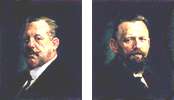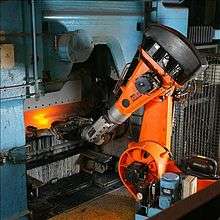KUKA
|
| |
| Aktiengesellschaft | |
| Traded as | FWB: KU2 |
| Industry | Automation |
| Founded | 1898 |
| Headquarters | Augsburg, Bavaria, Germany |
Key people | Till Reuter (CEO and chairman of the executive board), Bernd Minning (Chairman of the supervisory board) |
| Products | Industrial robots, automated production lines |
| Revenue | €2.095 billion (2014)[1] |
| €138.2 million (2014)[1] | |
| Profit | €68.1 million (2014)[1] |
| Total assets | €1,979.5 million (end 2014)[1] |
| Total equity | €541.1 million (end 2014)[1] |
Number of employees | 12,102 (end 2014)[1] |
| Divisions | |
| Website |
www |
KUKA is a German manufacturer of industrial robots and solutions for factory automation. The KUKA Robotics Corporation has 25 subsidiaries worldwide, mostly sales and service subsidiaries, including in the United States, Australia, Canada, Mexico, Brazil, China, Japan, South Korea, Taiwan, India, Russia[2] and most European countries. The company name, KUKA, is an acronym for Keller und Knappich Augsburg.
History

The company was founded in 1898 in Augsburg, Germany, by Johann Josef Keller and Jacob Knappich. At first, the company focused on house and street lights, but soon expanded to other products (welding equipment and solutions; big containers), to become the market leader in communal vehicles in Europe by 1966. Keller & Knappich GmbH merged with part of Industrie-Werke Karlsruhe AG to become Industrie-Werke Karlsruhe Augsburg Aktiengesellschaft, eventually KUKA for short.
In 1973, KUKA created its own industrial robot FAMULUS.[3][4] At that time, the company belonged to the Quandt group. However, in 1980, the Quandt family withdrew and a publicly owned firm was established. In 1995, the company was split into KUKA Robotics Corporation and KUKA Schweißanlagen (now KUKA Systems), now both subsidiaries of KUKA AG. The company is a member of the Robotics Industries Association (RIA), of the International Federation of Robotics (IFR) and of the German engineering association VDMA. Today, KUKA concentrates on solutions for the automation of industrial manufacturing processes.
In 2016, Midea Group offered to buy Kuka for about €4.5 billion ($5 billion). Midea is pursuing to become the largest shareholder by raising its stake beyond 70 percent.[5]
Most robots are finished in "KUKA Orange" (the official corporate color) or black.
Corporate data
The company is headquartered in Augsburg, Germany. As of December, 2014, KUKA employed more than 12,000 workers.<ref http://www.kuka-ag.de/en/investor_relations/key_figures/ name="AnnualReport2014" /> While previously emphasizing customers in the automotive industry, the company has since expanded to other industries.
Notable milestones
1971 – Europe’s first welding transfer line built for Daimler-Benz.
1973 – The world’s first industrial robot with six electromechanically driven axes, known as FAMULUS.
1976 – IR 6/60 – A completely new robot type with six electromechanically driven axes and an offset wrist.
1989 – A new generation of industrial robots is developed – brushless drive motors for a low maintenance and a higher technical availability.
2007 – KUKA Titan – at the time, the biggest and strongest industrial robot with six axes, entered into the Guinness Book of World Records.[6]
2010 – As the only robot family, the robot series KR QUANTEC completely covers the load range of 90 up to 300 kg with a reach of up to 3100 mm for the first time.
2012 – The new small robot series KR AGILUS is launched.
2014 – On February 9, the company uploaded a video on its official YouTube channel KukaRobotGroup, teasing the audience with their new KUKA robot, specialized in Table Tennis. The teaser video shows a trailer of KUKA's robot initiating fight against a human in Table Tennis. The human is Timo Boll, a legend in table tennis. This new robot is described as KUKA KR AGILUS, Fastest Robot on Earth. The full video was available on March 10, 2014. The video is not a real match but a commercial with heavy CGI, and received strong criticism from the table tennis community. The video has been viewed over 6 million times on YouTube and has won numerous awards.[7]
System information and application areas




System information
The KUKA system software is the operating software and the heart of the entire control. In it all basic functions are stored which are needed for the deployment of the robot system.
Robots come with a control panel that has a display resolution of 640 x 480 pixels and an integrated 6D mouse, with which the manipulator is moved, positions are saved (TouchUp), or where modules, functions, data lists, etc. are created and modified. To manually control the axes, the enabling switch on the back of the control panel (the KCP, or KUKAControlPanel) must be activated (today only with a panic function). The connection to the controller is a VGA interface and a CAN-bus.
A rugged computer located in the control cabinet communicates with the robot system via an MFC card. Control signals between the manipulator and the controls are transferred using the so-called DSE-RDW connection. The DSE card is in the control cabinet, the RDW card in the robot socket.
Controls for the old KRC1 types used Windows 95 to run VxWorks-based software. Peripheral equipment includes a CD-ROM and a disk drive; Ethernet, Profibus, Interbus, Devicenet and ASI sockets are also available.
Controls for the newer KRC2 type use the Windows XP operating system. Systems contain a CD-ROM drive and USB ports, Ethernet connection and feature optional connections for Profibus, Interbus, DeviceNet and Profinet.
Application areas
The industrial robots are used in a number of application areas, such as material handling, loading and unloading of machines, palletizing and depalletizing, spot and arc welding. They are used in a number of large companies, predominantly in the automotive industry, but also in other industries such as the aerospace industry. Specific applications include:
- Transport industry: for the transport of heavy loads, where their load capacity and free positioning are used.
- Food and beverage industry: for tasks such as loading and unloading of packaging machines, cutting meat, stacking and palletizing, and quality control.
- Construction industry: e.g. for ensuring an even flow of material.
- Glass industry: used, for instance in the thermal treatment of glass and quartz glass in laboratory glass production, bending and forming operations.
- Foundry and forging industry: the robots' heat and dirt resistance enables them to be used directly before, in and on the casting machines. They can also be used for operations such as deburring, grinding, or drilling, and for quality control.
- Wood industry: for grinding, milling, drilling, sawing, palletising or sorting applications.
- Metal processing: for operations such as drilling, milling, sawing or bending and punching. Industrial robots are used in welding, assembly, loading and unloading processes.
- Stone processing: the ceramic and stone industries use the industrial robots for bridge sawing
KUKA Entertainment
In 2001, KUKA formed a partnership with RoboCoaster Ltd to develop the world's first passenger-carrying industrial robot. The ride uses roller coaster-style seats attached to robotic arms and provides a roller coaster-like motion sequence through a series of programmable maneuvers. Riders themselves can also program the motions of their ride. A second generation system, the RoboCoaster G2, was deployed at Universal's Islands of Adventure theme park in Orlando, Florida in 2010, in conjunction with Dynamic Structures. Harry Potter and the Forbidden Journey's seats are mounted on robotic arms, which are in turn mounted on a track allowing the arms to travel through the attraction while performing their movements in synchronization with the ride's show elements (animated props, projection surfaces, etc.).[8][9][10][11]
KUKA's partnership with RoboCoaster has also seen KUKA robots appear in a number of Hollywood films. In the James Bond film Die Another Day, in a scene depicting an ice palace in Iceland, NSA agent Jinx, played by Halle Berry, is threatened by laser-wielding robots. In the Ron Howard film The Da Vinci Code, a KUKA robot hands Tom Hanks’ character Robert Langdon a container containing a cryptex.
In 2007, KUKA introduced a simulator, based on the Robocoaster.[12] This product is not marketed by RoboCoaster Ltd. An installation of this version is The Sum Of All Thrills ride at EPCOT in Lake Buena Vista, Florida.
See also
References
- 1 2 3 4 5 6 "Annual Report 2014" (PDF). KUKA. Retrieved 2015-08-04.
- ↑ "KUKA in Russia". Retrieved 2013-07-31.
- ↑ Company history located on the KUKA Robotics Homepage
- ↑ "History of Industrial Robots" (PDF). Retrieved 2012-10-27.
- ↑ "Midea reaches 86 percent stake in Kuka in takeover offer". Reuters. 20 Jul 2016. Retrieved 2016-07-24.
- ↑ Guinness World Records Ltd. (Hrsg.): Guinness World Records 2007. Bibliographic Institute, Mannheim, 2007. ISBN 978-3411140770
- ↑ Press Release from 12 May 2015, Retrieved August 6th 2015
- ↑ Harry Potter World Orlando (March 22, 2010). """Harry Potter and the Forbidden Journey" Attraction Details"". Harry Potter World Orlando. Retrieved 2014-01-24.
- ↑ Kuka Entertainment. "Kuka Entertainment - Robocoaster". Kuka Entertainment. Retrieved June 29, 2010.
- ↑ Kuka Industrial Robots. "Kuka Industrial Robots - Robocoaster". Kuka Industrial Robots. Retrieved June 29, 2010.
- ↑ Robocoaster (March 22, 2010). "Large & Theme Park Solutions". Robocoaster. Retrieved June 29, 2010.
- ↑ "KUKA Entertainment 4D Simulator". Retrieved 2008-01-11.
- Most of the content of this article comes from the equivalent German-language Wikipedia article.
- Wiki CAEX page
- Wiki Georgia Institute of Technology page
External links
| Wikimedia Commons has media related to KUKA AG. |
- Official website
- KUKA Robotics Corp. (USA)
- KUKA LBR iiwa (Lightweight Robot, intelligent industrial work assistant
- Timo Boll vs Kuka Robot Ping Pong duel (YouTube)
Coordinates: 48°22′12″N 10°56′08″E / 48.37°N 10.93565°E